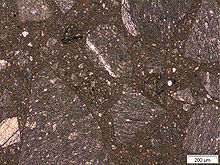
Back Kataklasit German Cataclasita Spanish Cataclasite French Cataclasite Italian Cataclasiet Dutch Kataklazyt Polish Cataclasito Portuguese 壓碎岩 Chinese


Cataclasite is a cohesive granular fault rock.[1] Comminution, also known as cataclasis, is an important process in forming cataclasites.[2] They fall into the category of cataclastic rocks which are formed through faulting or fracturing in the upper crust.[3] Cataclasites are distinguished from fault gouge, which is incohesive, and fault breccia, which contains coarser fragments.[1]
- ^ a b Sibson, R. H. (1977). "Fault rocks and fault mechanisms". Journal of the Geological Society. 133 (3): 191–213. Bibcode:1977JGSoc.133..191S. doi:10.1144/gsjgs.133.3.0191. S2CID 131446805.
- ^ Fossen, Haakon (2010). Structural Geology. United Kingdom: Cambridge University Press. ISBN 978-0-521-51664-8.
- ^ Higgins, Michael W. (1971). Cataclastic Rocks (Report). USGS Professional Paper 678. doi:10.3133/pp687.